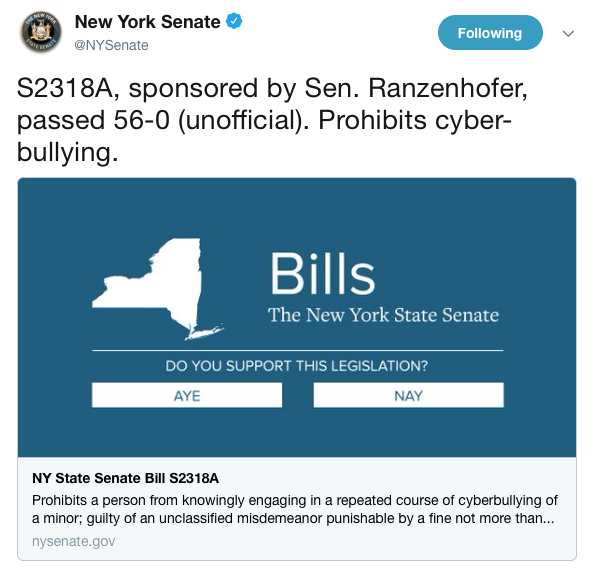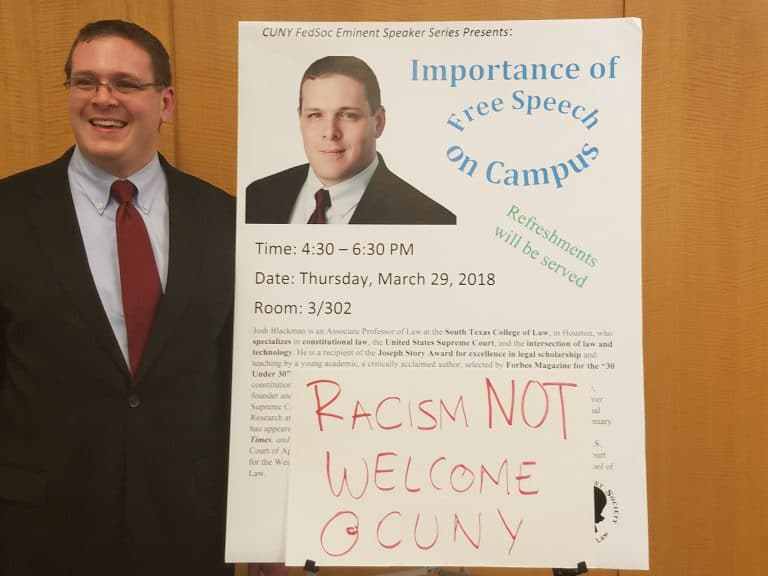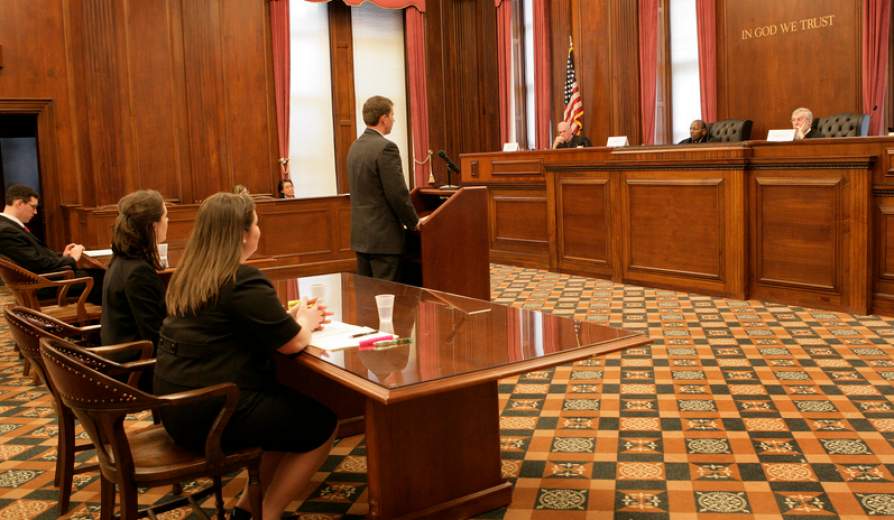 Last week I saw a tweet come into my feed from the NY Senate about the 56-0 passing of a cyberbullying bill. I quickly knocked out a post ripping it for two reasons: The complete lack of a definition and the fact that it violated the First Amendment.
Last week I saw a tweet come into my feed from the NY Senate about the 56-0 passing of a cyberbullying bill. I quickly knocked out a post ripping it for two reasons: The complete lack of a definition and the fact that it violated the First Amendment.
That post was picked up by Scott Greenfield. Then Greenfield’s post was seen by Tim Cushing at Techdirt. Which in turn was seen by Eugene Volokh. A little old school blogging as people added thoughts.
Now I have more to add: The first being a semi-correction that includes some additional criticism of the Senate. But the second is some actual praise.
First, as Volokh pointed out, the bill was an amendment to the Education Law, and the Education Law has an existing definition of cyberbullying that is defined elsewhere. The first of the Senate’s failings was the lack of a reference to that definition section.
That lack of a reference, Greenfield points out today in likewise doing a second post on the subject, threw us both off as this isn’t the way New York usually drafts its statutes. As Greenfield notes:
Had it been the Senate’s intent to borrow the definition from another section of the Education Law to create its new crime, and, indeed, to establish the basic elements of the offense as would be minimally necessary for a crime to pass constitutional muster, there should have been a reference in the new crime to the definition upon which it relies. This is how New York laws are drafted, how a criminal offense is framed as to contain the bare minimum required to establish the elements of the offense.
It never occurred to Turk or me that there would be a New York law devoid of a definition or elements which would leave it to us to go searching the laws to figure out whether there was some definition, something to establish the elements of the offense, lurking in the darkness somewhere else. You don’t do that. You don’t create a crime and omit either the definition or an express reference back to the section setting forth the definition upon which the legislators relied.
This failure of form, hoping for an implicit reference to the definitions section that exists elsewhere, is the lesser of the two problems. Because that existing definition is so chock full of vagaries as to render it unconstitutional as a criminal statute. These are the provisions (as originally made into law for school administrative purposes, not criminal purposes):
the creation of a hostile environment by conduct or by threats, intimidation or abuse, including cyberbullying, that
(a) has or would have the effect of unreasonably and substantially interfering with a student’s educational performance, opportunities or benefits, or mental, emotional or physical well-being; or
(b) reasonably causes or would reasonably be expected to cause a student to fear for his or her physical safety; or
(c) reasonably causes or would reasonably be expected to cause physical injury or emotional harm to a student; or
(d) occurs off school property and creates or would foreseeably create a risk of substantial disruption within the school environment, where it is foreseeable that the conduct, threats, intimidation or abuse might reach school property.
Acts of harassment and bullying shall include, but not be limited to, those acts based on a person’s actual or perceived race, color, weight, national origin, ethnic group, religion, religious practice, disability, sexual orientation, gender or sex. For the purposes of this definition the term “threats, intimidation or abuse” shall include verbal and non-verbal actions.
So let’s say that Student A passes Student B in the hall. A smiles at B. Then A texts to B, “I’ll see you on the playground at lunch!”
Are they friends? Enemies? Was A flirting with B? Threatening B? Does A simply want to hang out with B? Should B be afraid? Enthralled? Bored to tears?
Would this conduct and speech “reasonably be expected to cause a student to fear for his or her physical safety?”
Would this conduct and speech, unreasonably and substantially interfere with a student’s educational performance, opportunities or benefits, or mental, emotional or physical well-being?
Who the hell knows?
And if you can’t figure out whether something is a crime or not, then the law is vague. And it is likewise over broad as it will sweep up into its net perfectly innocent conduct and speech.
But there is another part to this posting. And that part is praise.
The praise is not for the bill, but for the Senate’s use of Twitter to quickly and cheaply disseminate information in an easily accessible form to the public.
For all the howling and caterwauling about how bad Twitter is, filled with bots, trolls, and those who think they will somehow “win” arguments and “own” their opponent, the one thing it is particularly good at is the rapid dissemination of information by public bodies.
That is how I easily found the bill’s Senate passage, and that is what allows us to publicly debate it’s merits.
So. The bill itself gets an F, but the Senate’s information distribution gets an A+.


